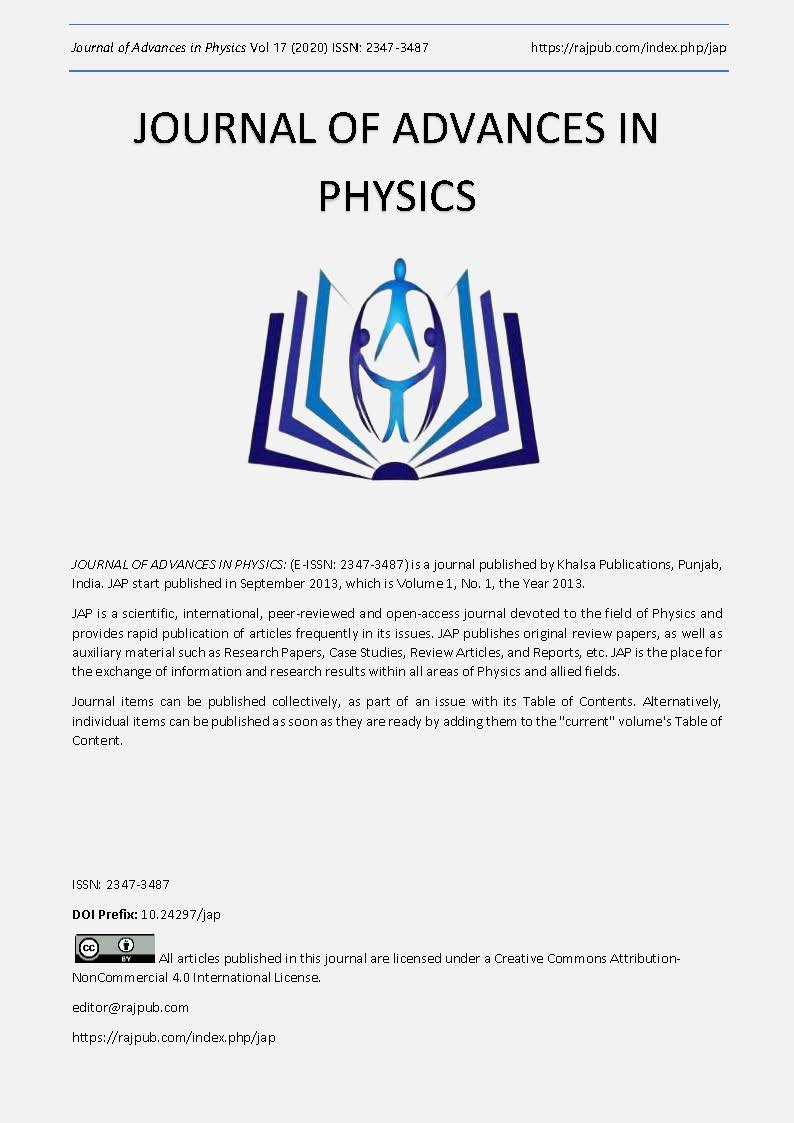Mathematical Modeling of Photovoltaic Properties of Nipc/P-Si (Organic/Inorganic) Heterojunction by Using Artificial Neural Networks Model
DOI:
https://doi.org/10.24297/jap.v17i.8718Keywords:
Modeling, Artificial Neural Network (ANN) Model, Photovoltaic Properties , (Organic/Inorganic) HeterojunctionAbstract
In this research, the artificial neural network (ANN) and resilient back propagation (R-prop) training algorithm are utilized to model the photovoltaic properties of Nickel–phthalocyanine (NiPc/p-Si) heterojunction. The experimental data are extracted from experimental studies. Experimental data are utilized as inputs in the ANN model. Training of different structures of the ANN is processed to approach the minimum value of error. Eight artificial neural networks are trained to get a better mean square error (MSE) and best execution for the networks. The ANN performances are also investigated and their values are very small (MSE < 10-3). The simulation results of the current-voltage characteristics of NiPc films are produced and provided excellent matching with the corresponding experimental data. Utilization of ANN model for predictions is also processed and gives accurate results. The equation which describes the relation between the inputs and outputs is obtained. The high accuracy of the ANN model has appeared in the major guessing power and the ability of generalization depending on the obtained equations.
Downloads
References
Ao, R., Kümmerl, L., Haarer, D. (1995). Present limits of data storage using dye molecules in solid matrices, Adv. Mater., 7 495-499. https://doi.org/10.1002/adma.19950070522
Ali, H. A. M., Mohamed R. A. (2018). Modeling for electrical impedance spectroscopy of (4E)-2-amino-3cyanobenzo[b]oxocin-6-one by artificial neural network, Ceramics International, 44 10907-10911. https://www.sciencedirect.com/science/article/pii/S0272884218307107?via%3Dihub
Attia, A.A., El-Nahas, M.M., El-Bakry, M.Y., Habashy, D.M. (2013). Neural networks modeling for refractive indices of semiconductors, Opt. Commun. 287 140-144. https://doi.org/10.1016/j.optcom.2012.09.016
Darwish, A.A.A. Hanafy, T.A., Attia, A. A., Habashy, D.M., El-Bakry, M.Y., El-Nahas, M. M., (2015). Optoelectronic performance and artificial neural networks (ANNs) modeling of n-InSe/p-Si solar cell, Superlattices and Microstructures 83 299-309. https://doi.org/10.1016/j.spmi.2015.03.033
El-Bakry, M.Y. (2003). Feed forward neural networks modeling for K–P interactions, Chaos Soliton Fract, 18 995-1000. https://doi.org/10.1016/S0960-0779(03)00068-7
El-Bakry, M.Y. (2004). A STUDY OF K–P INTERACTION AT HIGH ENERGY USING ADAPTIVE FUZZY INFERENCE SYSTEM INTERACTIONS, Int. J. Mod. Phys. C, 15 1013-1020. https://doi.org/10.1142/S0129183104006467
El.Barry, A.M.A., Habashy, D.M., (2019). Simulation and prediction of optical characterization of casting (Adamantan Fulgide) thin films using (CTANNs) approach.33(11) 1950093 https://doi.org/10.1142/S0217979219500930
El-Barry, A.M.A., Mohamed, R. A., (2019). Modeling of photovoltaic characteristics of pyronine thin film/p-Si single crystal, Material Research Express, 6(7) 2053-1591. https://doi.org/10.1088/2053-1591/ab0a34
El-Metwally, K.A., Haweel, T.I., El-Bakry, M.Y. (2000). A universal neural network representation for hadron hadron interactions at high-energy, Int. J. Mod. Phys. C, 11 619 - 629. https://doi.org/10.1016/S0129-1831(00)00053-5
El-Nahass, M.M., Farag, A.A.M., Darwish, A.A.A. (2005). Photovoltaic properties of NiPc/p-Si(organic/inorganic) heterojunctions, Organic Electronics, 6 129-136. https://doi.org/10.1016/j.orgel.2005.03.007
Gardner, J.W., Iskandari, M.Z., Bott, B. (1992). Effect of electrode geometry on gas sensitivity of lead phthalocyanine thin films, Sensors Actuators B 9 (2) 133 - 142. https://doi.org/10.1016/0925-4005(92)80206-D
Ghosh, A.K., Morel, D.L., Feug, T., Shaw,R. F., Rowe, C. (1974). Photovoltaic and rectification properties of Al/Mg phthalocyanine/Ag Schottky‐barrier cells, J. Appl. Phys. 45 230. https://doi.org/10.1063/1.1662965
Gregory, P. (1991). High-technology Applications of organic colorants, plenum press, New York https://doi.org/10.1007/978-1-4615-3822-6
Haisch, P., Winter, G., Hanack, M., Lüer, L., Egelhaai, H., Oelkrug, D. (1997). Soluble alkyl‐ and alkoxy‐substituted titaniumoxo phthalocyanines: Synthesis and photoconductivity, advanced materials, 9 (4) 316-321. https://onlinelibrary.wiley.com/toc/15214095/1997/9/4
Haweel, T.I. El-Bakry, M.Y., El-Metwally, K. A. (2003). Hadron–hadron interactions at high energy via Rademacher functions, Chaos Solitons Fract., 18 (2003) 159 168. https://www.sciencedirect.com/science/article/abs/pii/S0960077902005817
Kerp, H.R., van Faasen, E.E. (2000). Effects of oxygen on exciton transport in zinc phthalocyanine layers, Chem. Phys. Lett. 5 5-12. https://doi.org/10.1016/S0009-2614(00)01227-6
Khelifi, M., Mejatty, M., Berrchar, J., Bouchrriha, H. (1985). Photovoltaic effect in thin layers of phthalocyanines, Rev. Phys. Appl. 20 511-521. https://doi.org/10.1051/rphysap:01985002007051100
Lee, S.T., Wang, Y.M., HOU, X.Y., Tang, C.W. (1999). Interfacial electronic structures in an organic light-emitting diode, Appl. Phys. Lett., 74 (5) 670-672. https://doi.org/10.1063/1.122982
Linstead, R.P. (1934). Phthalocyanines. Part I. A new type of synthetic coloring matters, Journal of the Chemical Society, Part І 1016. https://doi.org/10.1039/JR9340001016
Mahapatro, A.K., Ghosh, S. (2001). High rectification in metal-phthalocyanine based single layer devices, IEEE Trans. Electron 48 (9) 1911-1914. https://doi.org/10.1109/16.944176
Mohamed, R. A., Habashy, D. M. (2018). Thermal Conductivity Modeling of Propylene Glycol - Based Nanofluid Using Artificial Neural Network, Journal of advances in physics, 14 (1) 5281-5291. https://rajpub.com/index.php/jap/article/view/7177
Mohamed, R. A. (2019). Prediction of AC conductivity for organic semiconductors based on artificial neural network ANN model, Material Research Express, 6(8) 085107-14 pages. https://doi.org/10.1088/2053-1591/ab250a
Mrwa,, A., Friedrich,, M., Hofmann, A., Zahn, D.R.T. (1995). Response of lead phthalocyanine to high NO2 concentration, Sensors Actuators 25 596 - 599. https://doi.org/10.1016/0925-4005(95)85130-5
Nada, R.H., Habashy, D.M., AbdEl-Salam, F., El-Bakry, M. Y., Abd El-Khalek, A.M., Abd E;-Reheim, E. (2013). Modeling of aging process for supersaturated solution treated of Al–3wt%Mg alloy, Mater. Sci. Eng. A 567 80-83. https://doi.org/10.1016/j.msea.2013.01.009
Reycroft, P.J., Ullai, H. (1980). Photovoltaic properties of polymer films, Solar Energy Mater. 2 217-228. https://doi.org/10.1016/0165-1633(79)90019-4
Tang, C.W. (1986). Two‐layer organic photovoltaic cell, Appl. Phys. Lett. 48 183-185. https://doi.org/10.1063/1.96937
Wohrle, D., Meissner, D. (1991). Organic solar cells, Adv. Mater. 3 129 - 138. https://doi.org/10.1002/adma.19910030303
Downloads
Published
How to Cite
Issue
Section
License
Copyright (c) 2020 R. A. Mohamed, Mahmoud. Y. El-Bakry , D. M. Habashy, E. H. Aamer

This work is licensed under a Creative Commons Attribution 4.0 International License.
 All articles published in Journal of Advances in Linguistics are licensed under a Creative Commons Attribution 4.0 International License.
All articles published in Journal of Advances in Linguistics are licensed under a Creative Commons Attribution 4.0 International License.




